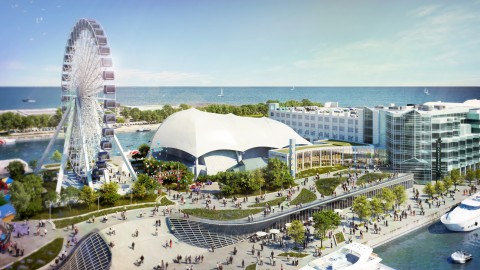Questions for an architect: Gordon Gill
Gordon Gill is a founding partner of the award-winning Chicago firm Adrian Smith + Gordon Gill Architecture (AS+GG). He and Adrian Smith are responsible for a staggeringly large number of the world’s supertall skyscrapers.
by Patrick Miner
Prior to founding AS+GG in 2006, Gordon was an Associate Partner at Skidmore, Owings & Merrill (SOM) and a Director of Design for VOA Associates. Gordon’s work includes the design of the world’s first net zero-energy skyscraper, the Pearl River Tower in Guangzhou, China (designed when he was with SOM); the world’s tallest building, Kingdom Tower in Jeddah, Saudi Arabia; and most recently the design of Astana Expo 2017 and its sustainable legacy community for Astana, Kazakhstan. These landmark projects strike a balance with their environmental contexts while still pursuing energy independence by harnessing the power of natural forces on site.
Gordon’s work also includes performing arts centers, museums and urban master plans. His designs have repeatedly been recognized by the American Institute of Architects. In 2009 Gordon was selected as Chicago’s Best Emerging Architect by the Chicago Reader, and in 2013 he was elected to the College of Fellows at the American Institute of Architects.
We recently sat down with Gordon to learn more about his work.
What project have you enjoyed working on most during your career thus far?
I can’t choose just one. I like working on a range of project types and scales. We are currently working on everything from supertall low-carbon towers to adaptive reuse projects which I thoroughly enjoy—primarily because much of the work is in uncharted territory and it demands the full process of analysis, design and delivery of the projects including procurement strategies and innovative system designs.
Our master plan work for new developments and cities is also very important to our vision for sustainable environments. Developing designs and guidelines for the execution of districts and cities is very rewarding. We are also currently working on two theater projects [including the Yard at Chicago Shakespeare Theater], which I really enjoy. Not just the architecture but also being around creative clients that have great passion and a wonderful sense of humor.
If you were not an architect, what would you be?
Maybe an F1 driver...
Many of your firm’s projects are supertall buildings in other cities. Do you think supertalls will return to Chicago? Would you like to design a tall building for Chicago?
I am optimistic that they will. I would love to design a supertall tower in Chicago—maybe a net zero-energy supertall.
What is Chicago’s biggest built environment challenge?
Adaptive reuse for a core that I understand to be approximately 11 percent vacant. That number may be slightly off but in principle, I’m concerned about the decay of space inside the core [of the city] and the displacement of population to different typologies outside the core. Over time, the impact of this departure from the center of the city might have detrimental consequences. I’m hoping that this is being addressed strategically by the [City of Chicago] and by the design community [in order to] create new environments that attract investment back into the core. I also think our infrastructure needs to be rethought. Not just repair but also understanding its inefficiencies and using technology to manage use as it relates to our fluctuating population in the city. Underutilized infrastructure can result in tremendous waste.
Mies van der Rohe or Frank Lloyd Wright?
Mies.






